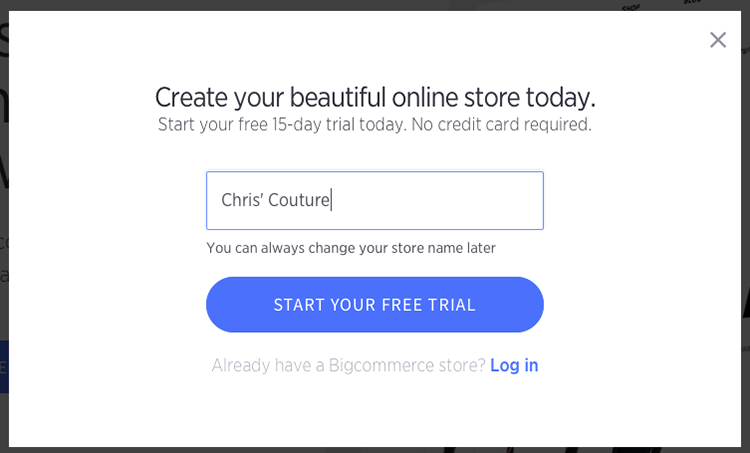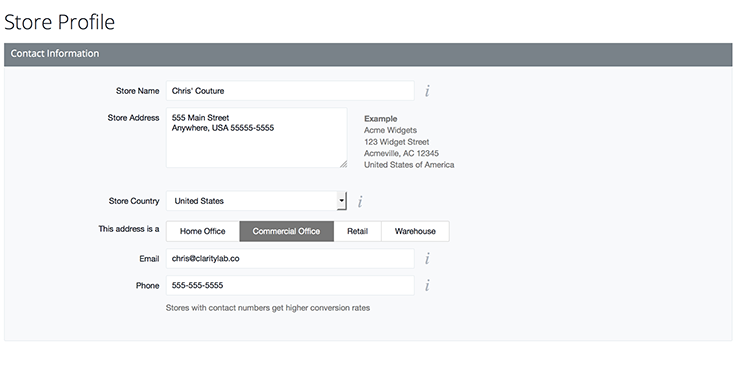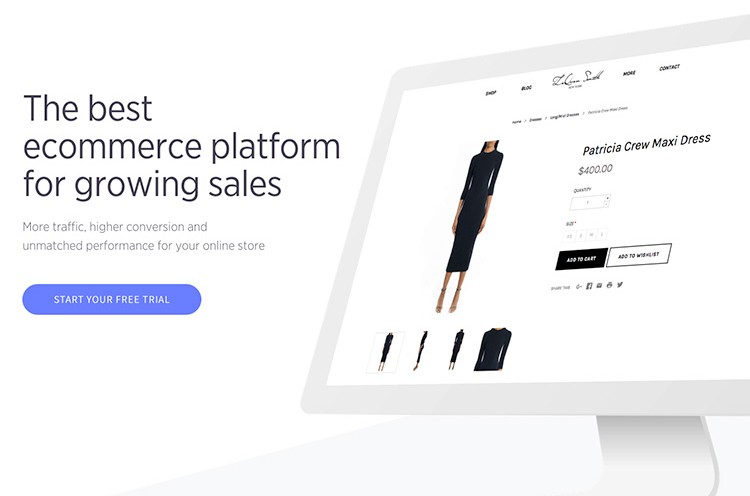
NOTE: This review was last updated on May 12, 2017.
I’m super excited to be doing this BigCommerce review – I’ve used the product for more than three years for one of my online stores, and I’m eager to share my experience (both the good and the bad) with you. I’m going to dive in deep and try to give you one of the most useful BigCommerce reviews around.
Spoiler alert: it’s almost all good.
Table of contents
What is BigCommerce?
What can BigCommerce do for you?
Getting Started
Store Setup
Store Dashboard
Setting Up Shop
Store Profile
Store Settings
Payments
Tax
Shipping
Currencies
Point of Sale Integration
Accounting Integration
Store Design
What’s For Sale?
May I Take Your Order?
Customer Management
Content Is King
Marketing
Search Engine Optimization (SEO)
Customer Support
The Good, The Bad, The Ugly
Our Rating
Conclusion
Reader Comments
What is BigCommerce?
Just in case you don’t know what BigCommerce is: it’s an e-commerce platform that actually lives up to its name: Big. It’s is Big on features, Big on performance, and Big on convenience. It’s is a “Saas” platform, which means “software as a service.” The software runs on powerful servers at their headquarters, so you don’t have to worry about a thing, except managing your products and orders.
They’ve taken care all of the hairy computer stuff for you, such as web hosting, SSL certificates, code upgrades, and security – it’s like living in a beautiful apartment as opposed to buying a house – the grass is cut for you, and there’s always someone to call if the sink gets clogged). Saas platforms are quickly becoming a standard for E-commerce and BigCommerce is arguably one of the best ones out there for retail businesses (large to small).
It’s designed to allow you to quickly and easily create a great-looking online store, complete with most of the features and ease of use that you’ve experienced at high-quality custom e-commerce markets such as Nordstrom.com or Fab.com.
As a company, it’s large and growing fast and I’ve been impressed with them overall as a service provider.
Before I go any further, just a quick heads up for you: there are affiliate links in this review, which means that if you click on a link to go check out BigCommerce (like that one) and you eventually sign up for a paid account, we’ll get a small commission.
Those small commissions allow us to keep giving you free, in-depth, helpful software reviews. Just know that the potential commissions for any given piece of software review do not sway our opinion of it towards the positive. Most of our reviews have affiliate links, even competing apps in the same category. This levels the playing field, allows us to be totally honest, and earn money while we help you for free. You win, we win, and the software companies win. All good all around.
So, if you’d like to support us here at Clarity Lab (and keep us cranking away at testing and reviewing software for you), and if you’re interested in checking out Big Commerce, click on one of our links to their site to get over to theirs. Okay, let’s get to it.
What can BigCommerce do for you?
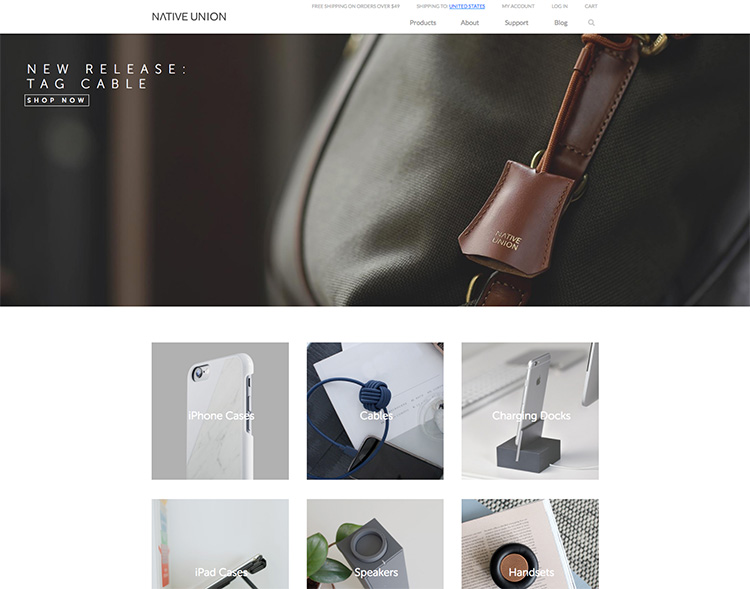
With this platform, you can VERY quickly build an online store (like the one in the image above, which is powered by it) with your own domain name where your customers can browse or search for your products, and purchase via credit card, Paypal, check, cash, etc. It has many available design templates which quickly give you an appealing look and feel that makes sense for your business, and the design templates can also be customized if you’re looking for something special.
It also has a powerful administration console that lets you manage your online store from soup to nuts: order processing, shipping labels, tracking inventory and some basic accounting features and reports. There are also tons of really great plug-ins to expand your store to do even more, such as integrating with your Quickbooks account to simplify accounting, or copying your new customers’ information into MailChimp (an email marketing platform) so you can keep in touch and let them know how much more you have to offer.
There’s plenty more – this is just the tip of the iceberg. Let’s dig into the features of this platform and I’ll show you what the experience of setting up a store is like.
Getting Started
Alrightee. Let’s take a tour through the inside of this software from the perspective of you setting up your own brand new store. You can follow along with the sections of the review below that have steps, or you can sit back and enjoy the views as if you were on a tour bus in Paris. (Recent readers of this review have reported that it’s approximately 12.4% less interesting than a bus tour of Paris, but hey, this review is free and you don’t need to travel to Paris to experience it.)
I found it really easy to get started with it – they offer a 15-day trial membership so you can get in and check things out. Just provide a few pieces of info and BAM you have your own online store! I highly recommend taking it for a free trial spin (and ANY software you are interested in). It’s absolutely the best way to test out how your life as a business owner will be inside a software that you will (hopefully) use daily. If you determine that it’s right for you, you can choose between several different price points and feature sets. The one you choose will be based on your specific businesses needs and also on your traffic and sales.
Store Setup
To get started with your trial just head over here and click the “Get Started” button. You’ll be asked for a Store Name, and a few other pieces of information, such as your name and email address. Click “Create Your Store Now” and you’re off and running. Booyah!
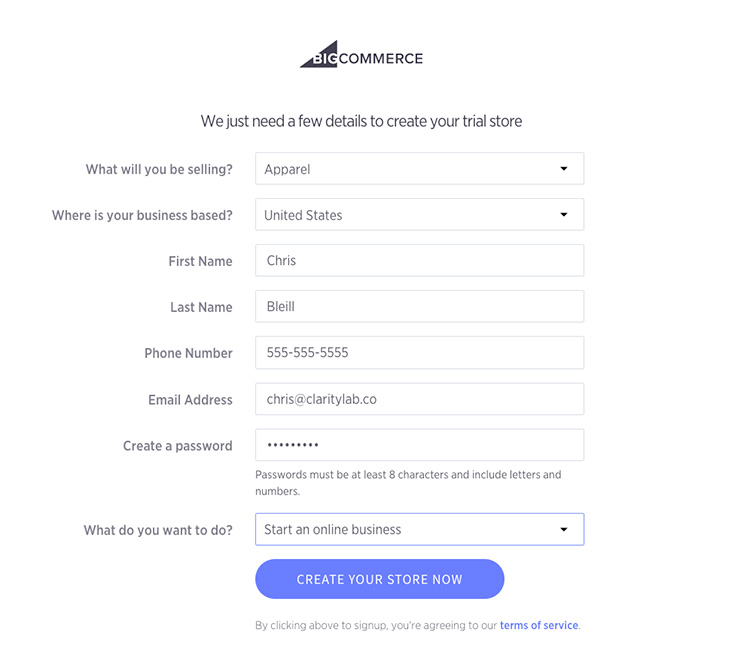
Once you click “Create Your Store Now”, grab an espresso while your store is being created, and get ready to have some caffeinated fun…
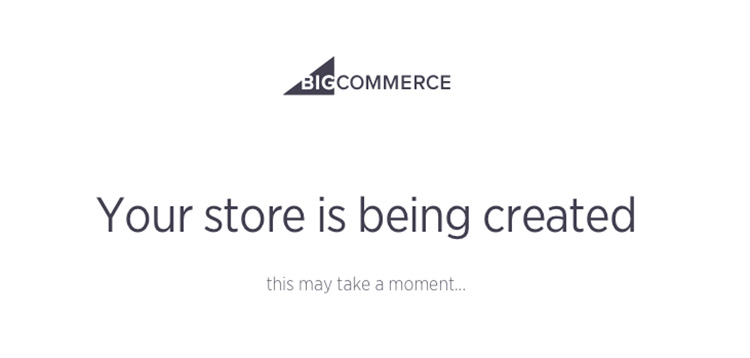
Store Dashboard
Once your store is created, you’re taken to a Store Dashboard, where you can view the status of your store, access different aspects of your business and configure your store just how you want it. (If you like tracking sales stats like I do, this is where you’ll come to look for a quick hit of dopamine in your brain as a result of a bunch of new sales happening while you were asleep.)
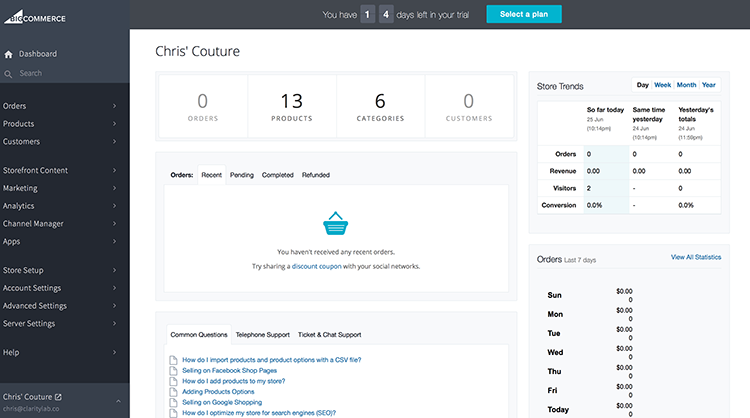
I find the menu options on the Dashboard very easy to navigate and understand. The category groupings are logically laid out, and if there’s something I’m looking to change with my store and I can’t figure out where to do it, chances are I’ll find it under the “Store Setup” option.
I’d like to take a minute and go through the different configuration options under the Store Setup, as there’s a LOT there and it’s important to understand what you can configure to make sure that this platform is the right platform for your e-commerce store.
Setting Up Shop
Once your store is created, you can head off to the “Store Setup” section, which has the following categories of options to customize your store to your particular business. Everything is pretty self-explanatory, and each option has a small information button next to it that you can “mouse-over” to get a tip for what that option does (very helpful for those of us who can’t quickly memorize what every little thing in a user interface does.)
Store Profile
In the Store Profile section you can name your store, supply the physical address of your store, and list your business email and phone number. In most store design templates, this information will automatically get published to the top of the store (for phone number and email) and added to a “Contact Us” page, so you don’t have to create one manually.
Store Settings
One of the most important sections of the Dashboard is the “Store Settings” option area:

The Store Settings area has some very important tabs:
Website: Set your store “Open For Business” (or “Down for Maintenance”), configure whether you use metric or imperial measurements, decimal places, etc. If you’re operating in the US, you probably won’t need to change any of this.
Display: Control how many Featured Products, Blog Posts, and Top Selling products show up on the Home Page, how many Reviews show up on each Product Page, whether to show your products in a List or a Grid, and a ton of more options. You can REALLY change the look and feel of your store just by changing the settings on this tab, and it’s actually really fun to tweak things here and see how it changes the look and feel of your store in real-time.
Image: Choose the sizes for the images on your website, such as product thumbnails, product images, etc. You can also control the number of items on each row in category pages here, and more.
Sharing: Choose which social media buttons to display on your site, and choose where each button links to (your Facebook page for example).
Language and Date: Choose your language and time zone. Unfortunately, there are no options for “snarky” or “sarcastic” language, which I’m slightly disappointed by.
Search: Super important tab here: choose what order search results appear on a search page. For instance, if someone puts “red shoes” in the Search bar on your store, you can choose whether the results are sorted in order of Price (Low or High), Bestsellers, Relevance to the search term, etc. What you choose here can really make a difference in how many people make a purchase on your site.
Miscellaneous: Control whether your store asks your customers for Product Reviews via email after purchase, whether it notifies you if someone fills their shopping cart and leaves the site, and a few other options to prevent Spam reviews on your site.
Payment
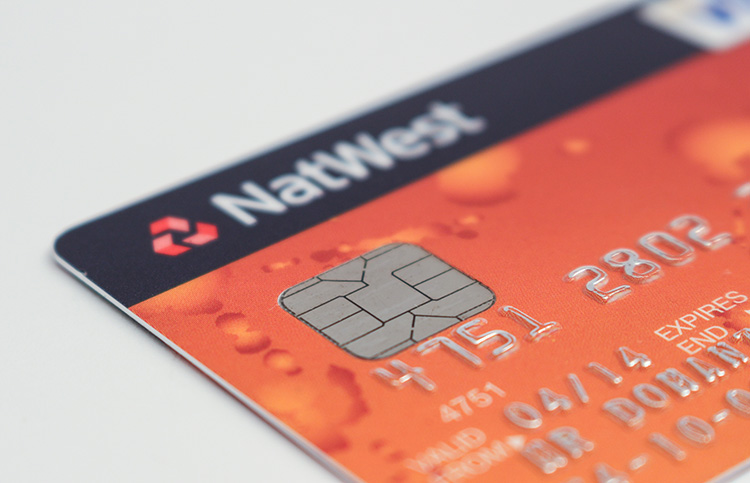
An e-commerce store wouldn’t be worth much without the ability to collect payments from its customers, right? Fortunately, BigCommerce leaves very few stones unturned in regards to collecting payment. As soon as your store is created, you can turn on the Braintree integration, which immediately gives you the ability to collect payment on the website with Visa, MasterCard, American Express, Discover, JCB, Diner’s Club, PayPal, Apple Pay, Android Pay, Venmo, Bitcoin, and most credit and debit cards. To top it off, there are no transaction fees for your first $50,000 of sales through Braintree (woot!).
If you already have an account with another payment provider and want to keep them, this platform also works seamlessly with more than 30 payment service providers, including Authorize.net, Square, WorldPay, Sage Payments, and QuickBooks Payments (click here for a list of currently supported and integrated payment providers.)
In addition to collecting payment at the time of order, you can take payment in one of multiple “offline” methods such as Bank Deposit, Cash On Delivery, Check, Money Order, and Pay in Store. What’s more, you can choose how these methods appear in the cart. For example, one of my online businesses accepts Purchase Orders, so I was able to rename the “Money Order” payment method to “Purchase Order” to allow my customers to place an order without having to specify credit card information. (Holy moly, that’s a lot of payment options, which is awesome for you and me. Like I said, they aren’t kidding when they put the word BIG in their business name.)
Tax
For anyone who has dealt with an online store (or any store for that matter), sales tax can be, well, a pain in the butt. Tax rates change constantly, and I’ve found myself constantly chasing my tail trying to keep my tax tables up to date in my online stores. The pain in my butt disappeared when I started using BigCommerce.
A few years ago they teamed up with sales tax gurus at Avalara to provide a free Automatic Sales Tax calculation capability in the BigCommerce shopping cart. So basically, you have to do nothing: tax rates are updated automatically and calculated correctly every time. (Whoooooosh. Do you hear that? That’s the sound of a summer breeze gently blowing through the leaves above you as you take a nap in a shady hammock because of all the time you saved by NOT having to constantly update the tax rates in your ecommerce platform.)
You also have the ability configure prices inclusive or exclusive of tax and control the way that sales taxes are configured for shipping and for gift wrapping. For instance, in my store, I choose not to charge sales tax on shipping because our items ship via truck, but in many states and situations it’s required to collect a base sales tax on shipping and handling charges.
No matter your situation, everything can be easily configured to handle it correctly.
Added bonus: if you want, you can sign up for advanced sales tax handling from Avalara and they can handle filing your sales tax reports to the state for you and even make the payments for you. Massive time-saver for an entrepreneur without a dedicated bookkeeping team! (It also moves that hammock to a tropical location.)
Shipping

Unless you’re selling downloadable products (which we will I’ll get into in a moment), you’re going to have to ship your goods to your customers. Providing accurate shipping prices so you don’t lose money on shipping, handling, labeling, and packing of the products to ship, not to mention keeping the customer informed of the status of their shipment, are all time-consuming, tedious tasks. Thanks to the geniuses at BigCommerce and their partners, much of this tedium can be reduced or removed.
Need to ship all or some of your products for Free? Done. There’s an option for that. Need to ship by Weight or by Order Value? Done. Need accurate real time quotes from USPS, FedEx or UPS? Yep, it does that too.
Inside this app are all of these options for shipping, and each of them are totally configurable per country. Perhaps you’re a US retailer who ships for a certain rate to the continental US, but has to charge more to Canada or Mexico. With this platform it’s a piece of chocolate layered cake – just set up each country with its own allowable shipping methods and rates. As soon as your customer chooses their Country in the shopping cart or shipping estimator, the software takes care of the rest. As someone who’s been in the online ecommerce store trenches, I can tell you honestly that this is freaking AWESOME.
If you need a more complex shipping configuration (for example, you ship large items via Common Carrier/LTL, or you ship from different warehouses depending on the product purchased), they offer integrations to some fantastic plug-in products that can handle it.
My particular favorite is ShipperHQ, which allows estimation for Truck / LTL Shipping (for large products that UPS/FedEx can’t ship), shipping from different warehouses, and drop shipping from suppliers. It also has a very powerful rules engine that allows me to handle pretty much any advanced shipping situation that I’ve encountered. Some of the plug-ins come with an additional fee, but the time saved in handling orders and accurately quoting shipping prices is well worth it in my opinion.
Currencies
If you do business in multiple countries and currencies, there’s a very easy to use, powerful currency manager. You can easily add a Currency to be paired with a particular country or region that you do business in, and you can even set the exchange rate to be updated automatically.
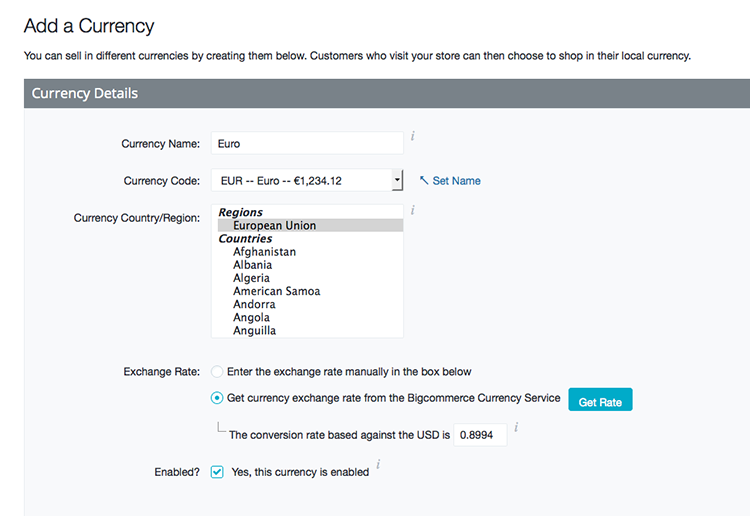
Point of Sale Integration
Many e-commerce merchants maintain one or more brick and mortar stores that sell the same inventory online and in the store. If you manage your Point of Sale (POS) for your brick and mortar store with Square, you can take advantage of the fantastic integration between BigCommerce and Square.
With this integration, you can use your existing Square account to process all of your payments and the inventory between Square and BigCommerce is automatically synced up, removing the tedious task of updating inventory and products across both tools and eliminating the problems common to online/offline retailers, such as over-selling because of incorrect inventory numbers. You can find out more about this integration here.
Accounting Integration
One of the most time intensive and error prone parts of my online business is keeping orders and inventory in-sync between my storefront and my accounting system. (The second most time intensive parts of my business is keeping my kids engaged in camps during the summer break.) For example, every time I get an order in my storefront, I have to duplicate that order in my accounting system, then come back after the order is fulfilled in the accounting system and update the storefront with status and shipping information.
The fine folks who built this e-commerce software recognize that this is a major pain point for their customers and have created a handful of integrations to commonly used accounting systems to streamline their customers’ businesses. (Are you noticing a theme here? I’m not making this stuff up. They pay a ton of attention to where all the painful bits are in the process of running an online e-commerce business, and they create streamlines workflows to remove the pain.)
The Quickbooks Online integration for example, synchronizes Orders, Products, Customers, Taxes, Discounts, Refunds and Shipping Charges from BigCommerce to Quickbooks Online. This eliminates time-intensive manual entry of data (which, trust me, is NOT fun) and removes human error from the data entry process. Again, a massive time-saving capability that is built right into the platform. I looked at similar integrations for one of my Magento stores and the prices started at $500 and went up from there. (Yikes.)
In addition to the Quickbooks Online integration, they also offer a Xero integration and also Saasu, FreshBooks, MYOB, Monsoon Stone Edge (using the OneSaas integration platform). If you’re not familiar with all those apps I just listed, they’re all business level bookkeeping apps.
Store Design
Personally, I really like tweaking the options in the dashboard and changing the configuration of how Sales Tax is handled, shipping is calculated, and integrating my accounting systems. (I know, I know. I’m an ecommerce geek.)
But I LOVE changing the way my store looks, and you can do the same in the Design Section.
A store’s appearance is based on a set of templates that are grouped into what are called “Themes”. If you’ve used a theme for your main website, such as a WordPress theme, you’ll already be familiar with this theme concept.
There are a number of Free themes that come right out of the box with, and plenty of Paid ones, too. The Free themes, in my opinion, look REALLY good and with a little tweaking can get many people just what they’re looking for.

Here’s a peek at the available Free themes at the time of this review:

As you can see, there are many different look-and-feel choices for a store right out of the gate, and the design section gives you immediate access to the HTML and CSS code for whatever theme you choose, to quickly customize and make it your own. (Also note that the preview of each theme shows how it will look on a small mobile device, like a phone, which means that all of their themes are mobile responsive. And that? Means that no matter what size screen your customers are shopping on, your ecommerce site will look sexy good, which will lead to more sales happening because like it or not, 50% or more of your store visitors will be on their phones while they’re shopping.)
For this review, I chose the “Bride to Be” theme, and here is exactly what my store looked like, without ANY configuration or customization:


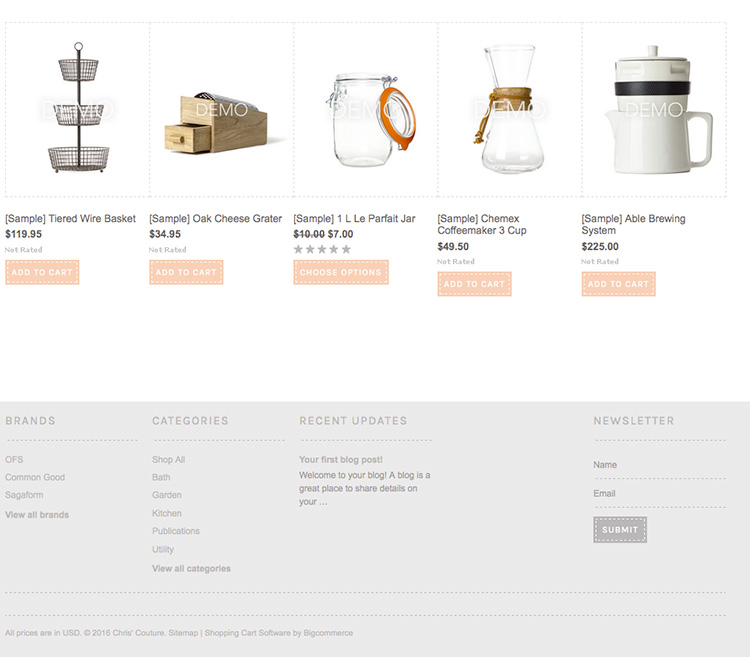
As you can see, it looks REALLY great, right out of the box. When my store was created, the software automatically added 13 sample products for me to see what the store would like when I got my products in there. In addition, each store comes with a Home Page slider carousel (that’s the Task Lamp picture near the top) that you can quickly replace with up to 5 of your own carousel pictures for a truly customized look and feel.
If you’re HTML/CSS savvy, you can easily change the colors and layout of the theme, and if you don’t know how to play with HTML and CSS code, no worries. There’s a really great community of BigCommerce specialists out there who can help you customize your store to your exact needs. (Yay for computer programmers!)
What’s For Sale?
Obviously, the core of an e-commerce store is the product. This app makes it REALLY easy to get your products into your store and looking great. You can do it a few different ways, but usually you’ll be doing it manually or uploading via a spreadsheet (for instance, if you’re a drop-shipper and get product upload files from your vendors. If you’re not familiar with the drop-shipping model, it’s where you sell products on your site, but you never actually touch the products. They’re shipped out from another company’s warehouse.)
Entering products manually through the admin console is pretty straightforward – it’s essentially a 3-4 step process where you enter the product name, SKU, description / selling points, upload product images, tell it how to track stock, and a few other things.
I was able to get each of my products into BC and looking good in about 5 minutes per product (a bit longer for products with a lot of variations or options, such as multiple sizes). There are also a lot of optional fields to fill out for each product, including data related to SEO (search engine optimization), Google Shopping, quantity discounts, etc.
It has a flexible way to configure additional options for your products as well. Honestly, I wasn’t a big fan of it when I first started my store, but once I understood how it was organized, my feelings changed. For example, if you have an apparel item (a t-shirt for example) that comes in multiple colors, you create an Option for each color.
Once you’ve defined each color as an Option, you create a “collection” of those color options (for example, “Shirt Colors”) as an “Option Set”. You might have one Option Set per product or the same Option Set might apply to multiple products. In the end, you end up with a MAJOR time saver with this workflow.
There is a lot you can do with the options, such as defining specific SKU’s for each option (T-SHIRT-BLUE-MED, T-SHIRT-RED-LRG as a basic example) so you can track inventory separately for each combination of size and color (It can also auto-generate the SKUs for you.)
You can change the price if a particular option is chosen (for example, increase the price if a more expensive fabric is selected for the shirt), modify the weight of the order (which is essential for accurate shipping charges), or change the picture of the item when an option is selected (show the red shirt image when the red option is chosen.)
It’s highly flexible, and yes, there is a bit of a learning curve, but once you get the hang of it, it really enhances the usability of your store, the management of your inventory, and the ease with which you can become a badass e-commerce business owner.
Here’s an example of the color option on the back-end:

And here’s how it looks in the store:
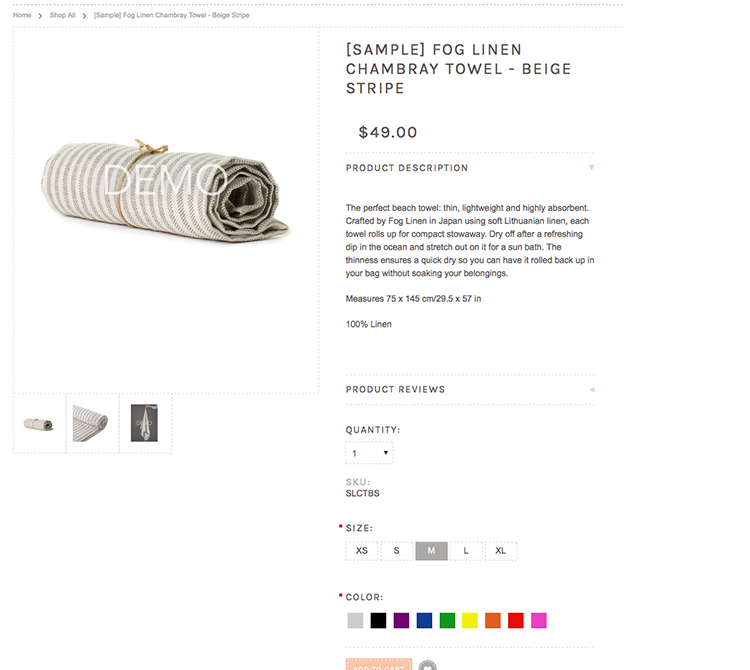
One thing that the Option system can’t do (at the time of this review) is create product options that depend on one another. For example, if you have a configurable product, such as a computer, that shows different options depending on the previous option choice (such as different hard drives based on the computer case size you select), you’re limited there. But for most purposes, I think their Option system right on the money.
In addition to selling physical products, you can offer downloadable products for sale, such as e-books or software. If you make the product downloadable, you can upload the file, give it a description, specify the number of times it can be downloaded, or a time range that it can be downloaded (otherwise known as the Mission Impossible “your product will self-destruct in 1-minute option.” Okay, that’s not really what it’s known as, but it should be.)
After dealing with years of selling a downloadable product through a WordPress site integrated with Paypal and an eJunkie account (major integration headache) – the ease of use of this software makes me smile.
One other cool function that I wish I had on every other e-commerce platform I’ve EVER USED is the “Find and show related products automatically” button. If you turn this On for a product, the code monkeys do their magic, and the system will automatically cross-sell related products to your customer on each product detail page (I’m guessing the monkeys do some sort of related product matching behind the scenes to determine other possible alternatives for your customer).
You also have the option of tracking visitor behavior and showing “Customers Also Viewed” for a particular product, which is a very effective conversion tactic made famous by a large online shopping website that will go unnamed (but which brings a large rainforest to mind.) Seriously though, inside of this platform, you’re getting the same kind of functionality that Amazon spent millions to custom build. All it takes for you to get it is a couple clicks. Take that Jeff Bezos.
May I Take Your Order?
Once you’ve got products in your store and you’re open for business, there’s the matter of processing all of those orders. But that’s a good problem to have.
This platform does an excellent job of making the fulfillment of an order a quick and painless process.
When a new order is placed, you get a new email and you can see all orders in the admin console, with a status (such as Pending, Processed, Shipped) so you can see what needs to be handled. Each order record has all of the information you need to complete the fulfillment, including Customer Shipping and Billing info, which products were purchased, and a nice big “Ship Items” button. Click on that bad boy and you can print USPS Priority labels right from inside the application, slap them on your shipment, and off you go.
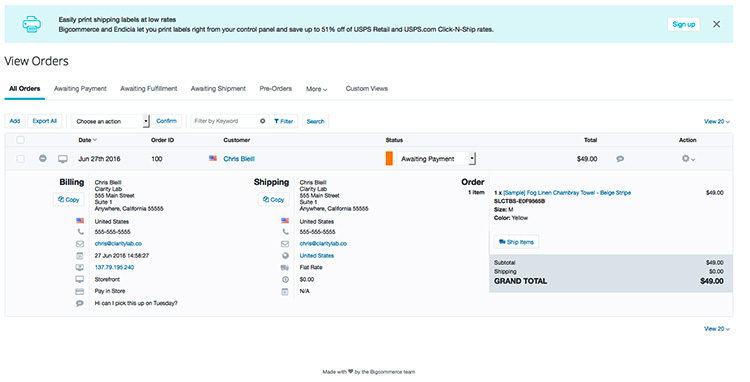
If you ship via another carrier such as FedEx or UPS, you can input the tracking information for the shipment, and your customer automatically gets a nice email with clickable shipment tracking links (which cuts way down on customer service calls and emails in my experience).
If you’re dealing with a high volume of orders each day (fingers crossed!), the system helps streamline your workflow by allowing you to upload a CSV file (a.k.a, a big ‘ol spreadsheet that you export in the .csv format) with all of your tracking numbers so you don’t need to do them one by one.
Customer Management
When managing customers in your system, it’s vital to be able to segment them into groups to allow for special incentives, tax handling, email marketing, or fun freebie gifts you might unexpectedly send them, because that’s just how you roll.
The platform has pretty good Customer Group management built right in. You can define a Customer Group and define a discount all on the same screen. The discount management is very flexible, allowing for storewide discounts, discounts across an entire category, or even just on a particular product.
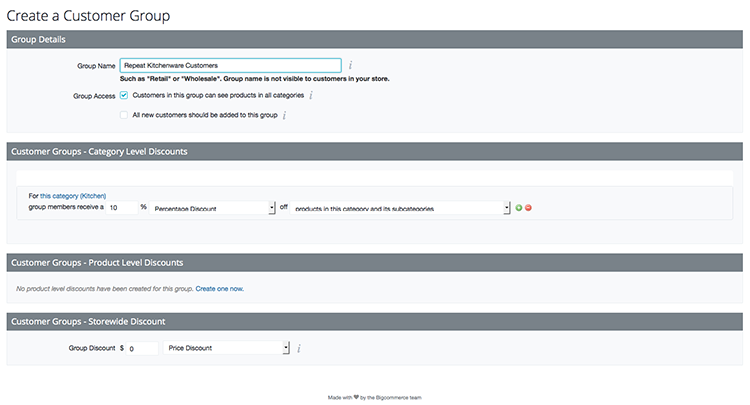
The Customer Groups are really easy to set up, and I’ve used them extensively in my store to keep folks coming back…because who doesn’t love a discount?
Content Is King
Besides the home page, categories, and product pages in an e-commerce store, there are a host of important pages that are essential for a good customer service experience. These pages include a Contact Us page, one or more policy pages (such as Shipping and Returns), and an About Us page.
Inside this platform is a very simple and powerful “Storefront Content” section, that allows you to create new Web Pages on your site with the click of a button. There’s a very simple WYSIWYG (what you see is what you get) text editor so you can format the text of your web page easily, and it’s simple to include images, links, tables and other HTML goodies into your page.
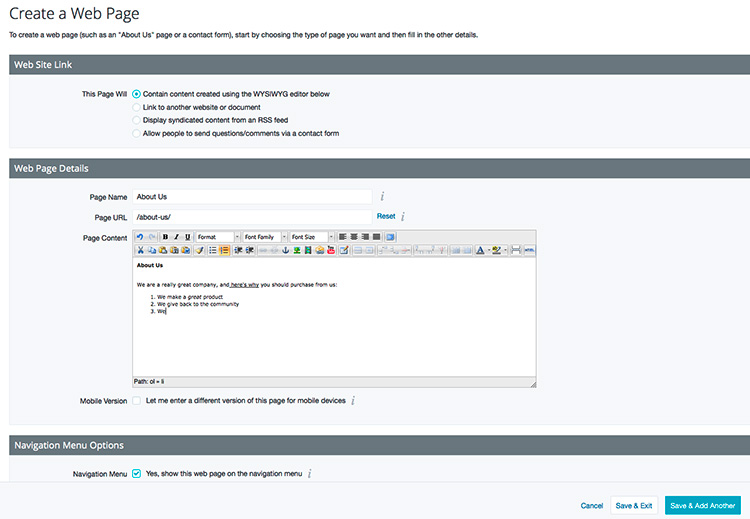
With each web page you create, you can choose whether it appears as a menu item on your main menu or not. You can even choose to make the web page your homepage, instead of the standard homepage for your theme.
In addition to web pages, there is also a “Blog” option, which makes it easy to quickly create Blog posts about your company, products, industry trends, or any kind of content marketing you might want to publish regularly on your blog.
This is a really great feature in my opinion, as it gives you the ability to add content to your site that is automatically indexed by search engines, and gives your website even more of a chance of being found by your customers (because they may be Googling around for something else and find one of your great blog posts. If they like your post, they might stick around for a little longer and head over to your store, and some of them will end up buying things from you. That’s content marketing in a nutshell, and it works wonders, even for e-commerce stores.)
Marketing
When it comes to promoting your products, BigCommerce has a bevy of really useful features and integrations:
- A Home Page carousel that features up to 5-page width images with configurable text and clickable buttons that you can feature products, category, sales, etc.
- Fully configurable text and image banners that can be inserted into your home page, category page, brand page or search results page. You can leave the banners on all the time, or specify them for a certain date range (for example, 2 weeks before Black Friday.)
- Any number of coupon codes to share with your customers, offering discounts on the whole order, shipping discounts, and free shipping. Coupons can be limited by number of uses by a customer or total number of uses (for instance if you have a limited number of free giveaway items).
- Flexible discount rules that apply to all customers or only customers in a certain group, giving the ability to do things like free shipping with a minimum order value, discounts off a particular brand, or a percentage discount of product B if product A is ordered. There are a TON of options here, pretty much only limited by your marketing imagination!
- Abandoned Cart Notifications are emailed to your customers who have left your site with an item in their cart. Customers get a friendly reminder about their item and a link back to your site to complete their order. This one saved a LOT of customers for me and is essential for any e-commerce store, especially one with a lot of shoppers using mobile phones (the phone always seems to ring right before they click “Purchase”.)
- Google Adwords and Yahoo Search Marketing listing generators to create ad listings for one or more categories in your store with the click of a button.
- It offers out-of-the-box integrations with multiple email marketing tools, such as MailChimp, Constant Contact, iContact, and Interspire. Your new customers can automatically be added to your email marketing tool groups, and set off a new auto-responder chain.
- Gift Certificate tool that allows your customers to purchase Gift Certificates for your store, to be given to friends, family, and customers as gifts.
- Ebay integration that allows you to list your products to your existing eBay seller account, and receive order notifications when those products sell in the eBay marketplace.
- Google Shopping Feed that easily creates a Google Shopping feed file that can be uploaded to your Google Merchant account for Product Listing Ads (think the items on the “Shopping” tab in a Google Search.) You simply define standard categories for your products, and off you go.
- Autogenerated feeds for Shopping Comparison sites such as Bizrate, Shopzilla and Beso.
With all of these features, you should have no issue getting your products in front of a host of interested customers.
Search Engine Optimization

While the built in marketing tools help push out your products to prospects and increase the likelihood of them converting into paying customers, no customer is “hotter” than the customer who is searching for the item that you sell via Google, Bing, or another search engine.
Having your site tuned up so that it appears in one of the top search result positions is a science in itself called “Search Engine Optimization” or SEO, and this platform has built the standards for good SEO right into the product. Below are some highlights of its SEO advantages.
(If you’re not familiar with SEO, some of this will sound like techno gibberish. Sorry about that. Unpacking what some of these SEO concepts mean would take a while. So, if you don’t know what some of are, just lightly read through them and know that they’re all important and valuable bits of the SEO game, and that the fact that this software makes it easy to do all these things is THE BOMB):
- Fully configurable meta Title, Keywords and Description, per product and per category.
- Alt tags on all product and category images.
- Product Reviews to encourage more content per product page.
- Many responsive design templates which make your site mobile-friendly, which is an important SEO factor, especially with Google.
- Content and Blog pages to add more searchable content for your site.
- Automatically generat a sitemap that is always up to date with all of your new product pages, category pages, and content pages. (Manually generating sitemaps is a YOOOGE pain.)
- Rich Snippets / Microdata to enhance your search result listings with information like ratings, pricing, brand and stock levels.
- Fully configurable URL structure to maximize your URL architecture as you see fit, with the default structure set to their recommended short SEO setting (e.g. https://mystore.com/ipod-nano/ ). You can set your URL settings for Product Pages, Category Pages and Web Pages independently, and you can follow their recommendations or create your own unique URL structure. Additionally, you can set the URL for each product and category page independently, so if you’re migrating from another e-commerce tool, you can preserve all of your existing URLS instead of having to create 301 redirects for all products (a good idea in my experience).
- Rel=”canonical” elements included so that you don’t get punished by the search engines for duplicate content across categories.
- Automatic 301 rewrites if you change a URL for a product or page, so you preserve any history of that link with the search engine and outside websites.
- The ability to configure your site for site-wide HTTPS (Enterprise plan only).
BigCommerce Customer Support

A big, powerful software as a service platform like this is only as good as their support team is. You can have a great app and a crappy customer support experience and that will kill the value of the app every time.
That’s not the case here, thankfully. Their customer service is outstanding. Period. During the startup phase of my store and throughout its lifetime, I would call or chat with them regularly and they were always friendly and usually able to help me resolve my issue or question on the first call. I always got an answer to my question, even if it took the customer service person tracking down a code monkey to figure it out. So a BIG +1 for their customer support. They nail this department.
The Good, The Bad and The Ugly
As I mentioned previously, I’m a 2+ year user of BigCommerce as a store owner and primary customer service person for my store. I’ve found it to be a very powerful, yet simple and flexible platform for my e-commerce store. Frankly, I love it.
Daily interaction with the Dashboard as I process orders is straightforward and easy to manage. I like the reports I get from the Analytics section (such as the Real Time report that shows me latest activity and where the customer is coming from). The ability to easily set up my store for paid search marketing in Google Shopping is a huge bonus. As an SEO specialist, I love the control it gives me on my URL architecture and it’s Schema.org microdata implementation. (Can you tell I have a geek crush on BigCommerce?)
Rating
Overall Clarity Lab Rating: 4 out of 5
I retain the 1 point for a few reasons:
- I’d love to see a “Quote” or “Proposal” feature built into the tool, where I could load an item into a temporary cart for a customer, and send them a link to it. Many of my customers need to get a quote first and get approval for a Purchase Order, and this would make my life a lot easier if that functionality were built in.
- At the time of this review, the “Product Filtering” functionality is only available in the “Enterprise” edition, which comes with a pretty hefty monthly price tag. I feel that Product Filtering is now a baseline piece of an e-commerce store that should be included in any platform, and I’m disappointed that it’s only available to customers with deeper pockets, when it comes right out of the box with other e-commerce platforms such as Magento.
- I’d love to see them bring back their dedicated IOS app for managing my store on the go.
Conclusion
Thanks for stopping by and listening to my ramblings on BigCommerce!
As I mentioned before, the best way to really know if a tool like this is right for you is to try it out. I highly recommend signing up for a free trial (no credit card required) and kicking the tires yourself. I hope I’ve given you a good overview of what to expect and some areas to take a deeper look at.
All the best,
~Chris


